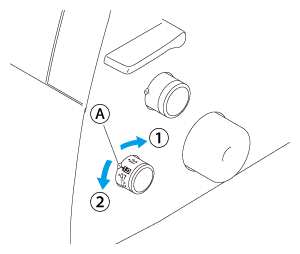AIR 1800
FAQs & Troubleshooting |

AIR 1800
Date: 06/13/2024 ID: faqh00000588_004
Differential feed adjustment
When sewing thick non-stretchable material such as denim, do not use the differential feed as it may damage the fabric.
This serger is equipped with two sets of feed dogs under the presser foot to move the fabric through the machine. The differential feed controls the movement of both the front and the rear feed dogs. When set at 1.0, the feed dogs are moving at the same speed (ratio of 1.0). When the differential feed ratio is set at less than 1.0, the front feed dogs move slower than the rear feed dogs, stretching the fabric as it is sewn. This is effective on lightweight fabric that may pucker. When the differential feed ratio is set at greater than 1.0, the front feed dogs move faster than the rear feed dogs, gathering the fabric as it is sewn. This function assists in removing the rippling when serging stretch fabrics.
Differential feed adjustment
| Differential feed ratio | Main feed (rear) | Differential feed (front) | Effect | Application |
|---|---|---|---|---|
| 0.7 - 1.0 | Material is pulled tight. | Prevents thin materials from puckering | ||
| 1.0 | Without differential feed. | Normal sewing | ||
| 1.0 - 2.0 | Material is gathered or pushed together. | Prevents stretch materials from stretching or puckering |
The normal setting is 1.0 on the defferential feed ratio adjustment dial.
To adjust the diffrerential feed, turn the dial on the right bottom of the machine.

(1) Less than 1.0
(2) Greater than 1.0
(A) Selection mark
To get smooth finish, adjust the feed ratio from 1.0 toward 2.0.
(The feed ratio required depends on the elasticity of the material.)
The more elastic the material, the further toward 2.0 the differential feed ratio should be set. Testsew with a scrap of the fabric to find the correct adjustment.
AIR 1800, AIRFLOW 3000
If you need further assistance, please contact Brother customer service:
Content Feedback
Please note this form is used for feedback only.